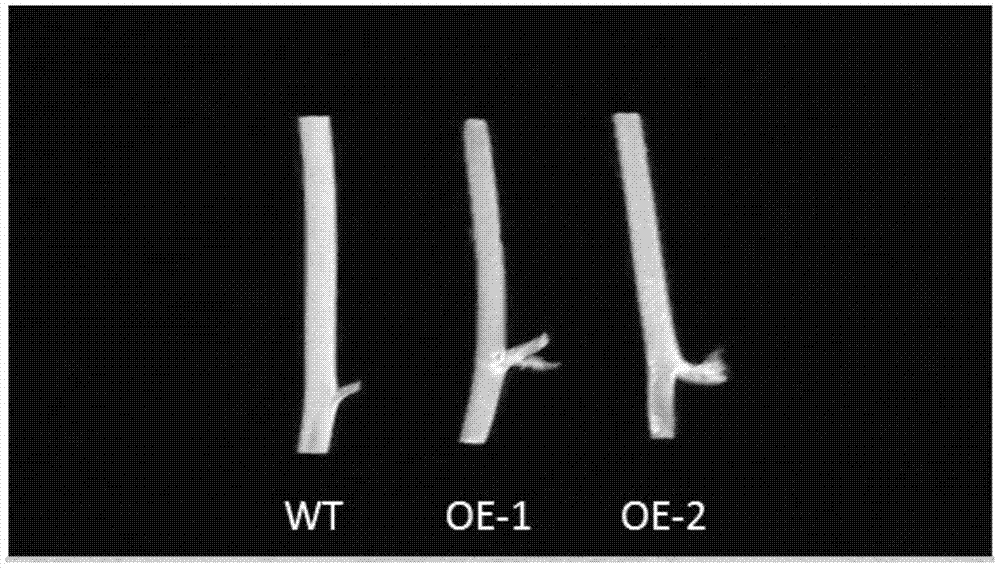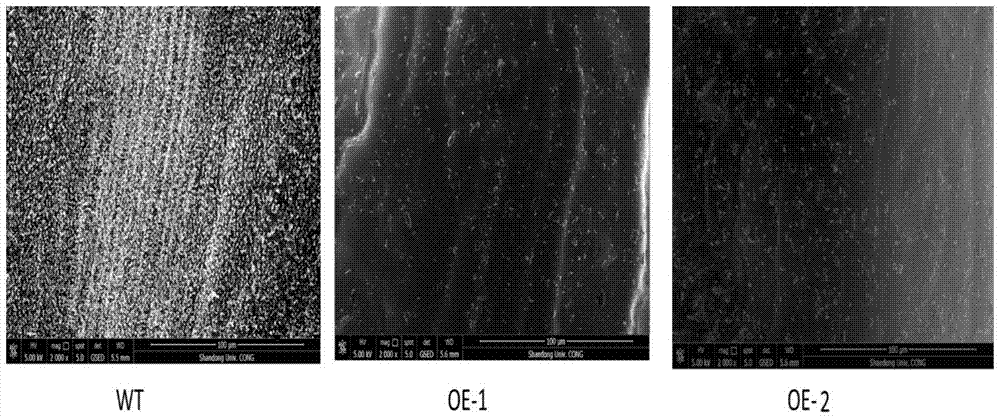Application of Arabidopsis thaliana glycosyltransferase gene ugt76d1 in reducing plant surface wax
A technology of UGT76D1 and glycosyltransferase, applied in the field of genetic engineering, can solve the problems that the function and application of surface wax have not been reported, and the special function of glycosyltransferase gene has not been revealed, so as to reduce surface wax and increase production , enhance the effect of absorption efficiency
- Summary
- Abstract
- Description
- Claims
- Application Information
AI Technical Summary
Problems solved by technology
Method used
Image
Examples
Embodiment 1
[0019] Example 1 Cloning of Arabidopsis Glycosyltransferase Gene UGT76D1
[0020] 1. Cloning of Arabidopsis thaliana glycosyltransferase gene UGT76D1
[0021] The cDNA sequence of the UGT76D1 gene was obtained through the public website http: / / www.cazy.org. Primers were designed according to the cDNA sequence, the forward primer was 76D1-F:5'-CGGGATCCATGGCAGAGATTCGCCAG-3', and the reverse primer was 76D1-R:5'-CGAGCTCTCATTGTTCGTCAATTTGCATC-3'. Arabidopsis RNA was extracted using TRIzol kit, and the full-length cDNA sequence of UGT76D1 gene was amplified by RT-PCR. The process of cloning the cDNA is first digested by BamHI and SacⅠ, and then connected to the pBluescript II SK(+) vector digested by the corresponding enzymes to construct a sequencing intermediate vector called pK76D1, and then use the vector to perform full-length PCR amplification of the gene And BamHI and SacⅠ enzyme digestion verification, and finally sequence determination to verify the correctness of the cl...
Embodiment 2
[0024] Example 2 Transgenic application of Arabidopsis thaliana glycosyltransferase gene UGT76D1
[0025] 1. Construction of cDNA expression vector containing UGT76D1 coding region
[0026] After the pK76D1 intermediate sequencing vector was digested with BamHI and SacⅠ, the full-length cDNA sequence with the cohesive ends was obtained. The gene fragment was connected with the pBI121 carrier part digested with corresponding enzymes to obtain a plant expression vector driven by the CaMV 35S promoter to overexpress the glycosyltransferase gene, called pBI76D1.
[0027] 2. Agrobacterium-mediated plant transformation
[0028] Agrobacterium GV3101 has the ability to infect plants and transfer genes, so the constructed UGT76D1 plant expression vector (pBI76D1) was transformed into Agrobacterium, and then verified by PCR and enzyme digestion. Arabidopsis flower buds were infiltrated with Agrobacterium GV3101 containing a plant expression vector using the flower dip method (a publis...
PUM
 Login to View More
Login to View More Abstract
Description
Claims
Application Information
 Login to View More
Login to View More - R&D
- Intellectual Property
- Life Sciences
- Materials
- Tech Scout
- Unparalleled Data Quality
- Higher Quality Content
- 60% Fewer Hallucinations
Browse by: Latest US Patents, China's latest patents, Technical Efficacy Thesaurus, Application Domain, Technology Topic, Popular Technical Reports.
© 2025 PatSnap. All rights reserved.Legal|Privacy policy|Modern Slavery Act Transparency Statement|Sitemap|About US| Contact US: help@patsnap.com



